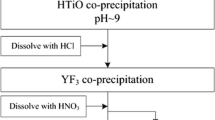Abstract
The methodology for the rapid determination of 89,90Sr in wide range of activity concentration is given. Methodology is based on simultaneous separation of strontium and yttrium from samples by mixed solvent anion exchange chromatography, mutual separation of 89,90Sr from 90Y by hydroxide precipitation and quantitative 89,90Sr determination by Cherenkov counting within 3 days. It is shown that Y and Sr can be efficiently separated from alkaline, alkaline earth and transition elements as well as from lanthanides and actinides on the column filed by strong base anion exchanger in nitrate form and 0.25 M HNO3 in mixture of ethanol and methanol as eluent. Decontamination factor for Ba, La and other examined elements except calcium is low and can not affect quantitative determination in predictable circumstances. Methodology for quantitative determination by Cherenkov counting based on following the changes of sample activity over time is described and discussed. It has been shown that 89,90Sr can be determined with acceptable accuracy when 89Sr/90Sr ratio is over 10:1 and that separation of Y enables reliable determination of 89Sr and 90Sr in wide range of 89Sr/90Sr ratios (60:1) and in some cases in presence of other yttrium and strontium isotopes. The methodology was tested by determination of 89,90Sr in Analytics crosscheck samples (nuclear waste sample) and ERA proficiency testing samples (low level activity samples). Obtained results shows that by using of low level liquid scintillation counter it can be possible to determine 89Sr and 90Sr in wide range of concentration activity (1–1,000 Bq/L/kg) with uncertainty below 10% within 2–3 days. Results also show that accuracy of determination of 89Sr (and 90Sr) strongly depends on the determination of difference between separation and counting time when activity ratio of 89Sr/90Sr is high. Examination the influence of media and vial type on background radiation and counting efficiency has shown that lowest limit of determination can be obtained by using of HNO3 in plastic vials as counting media, because in this combination figure of merit is maximized. For the recovery of 50% and 100 min of counting time estimated MDA is 55 Bq and 90 Bq for 90Sr and 89Sr, respectively. Analysis of combined uncertainty shows that it mainly depends on uncertainty of efficiency and recovery determination, uncertainty of activities determination for both isotopes and level of background radiation.








Similar content being viewed by others
References
Zhu S, Ghods A, Veselsky JC, Mirna A, Schelenz R (1990) Radiochim Acta 51:195
Horwitz EP, Dietz ML, Fisher D (1991) Anal Chem 63:522
Horwitz EP, Chiarzia R, Dietz ML (1992) Solvent Ext Ion Exch 10:313
Horwitz EP, Chiarzia R, Dietz ML (1992) J Radioanal Nucl Chem 161:575
Vajda N, Ghods-Esphahani A, Cooper E, Danesi PR (1992) J Radioanal Nucl Chem 162:307
Grate JW, Streblin R, Janata J, Egorov O, Ruzička J (1996) Anal Chem 68:333
Fliss M, Botsch W, Handl J, Michel R, Slavov VP, Borschtschenko VV (1998) Radiochim Acta 83:81
Grahek Ž, Eškinja I, Košutić K, Lulić S, Kvastek K (1999) Anal Chim Acta 379:107
Grahek Ž, Košutić K, Lulić S (1999) J Radioanal Nucl Chem 242:33
Torres JM, Tent J, Llaurado M, Rauret G (2002) J Environ Radioact 59:113
Chen QJ, Hou XL, Yu YX, Dahlgaard H, Nielsen SP (2002) Anal Chim Acta 466:109
Ageyev VA, Odintsov OO, Sajeniouk AD (2005) J Radioanal Nucl Chem 264:337
Grahek Ž, Rožmarić Mačefat M (2005) Anal Chim Acta 534:271
Grahek Ž, Košutić K, Rozmarić-Mačefat M (2006) J Radioanal Nucl Chem 268(2):179
Tovedal A, Nygren U, Ramebäck H (2008) J Radioanal Nucl Chem 276:357
Tovedal A, Nygren U, Ramebäck H (2009) J Radioanal Nucl Chem 282:455
Tovedal A, Nygren U, Lagerkvist P, Vesterlund A, Ramebäck H (2009) J Radioanal Nucl Chem 282:461
Vesterlund A, Tovedal A, Nygren U, Ramebäck H (2009) J Radioanal Nucl Chem 282:951
Jaggi M, Eikenberg J (2009) Appl Radiat Isot 67:765
Günther K, Lange S, Veit M (2009) Appl Radiat Isot 67:781
Heckel A, Vogl K (2009) Appl Radiat Isot 67:794
DeVol T, Clements JP, Farawila A, O′Hara HJ, Egorov OB (2009) J Radioanal Nucl Chem 282:623
Maxwell SL, Cullioan BK (2009) J Radioanal Nucl Chem 279:105
Maxwell SL, Cullioan BK (2009) J Radioanal Nucl Chem 279:901
Wallova G, Kandler N, Wallner G (2010) J Radioanal Nucl Chem 286:429
Landstetter C, Ringer W, Achtaz A, Katzzbererger E (2010) J Radioanal Nucl Chem 286:435
Kužel F, Staffova P, Špenditkova I, John J, Šebesta F (2010) J Radioanal Nucl Chem 286:729
Karacan F (2011) J Radioanal Nucl Chem 288:685
Dulanska S, Remenec B, Matel L, Galanda D, Molnar A (2011) J Radioanal Nucl Chem 288:705
Ometakova J, Dulanska S, Remenec B, Matel L (in press) J Radioanal Nucl Chem. doi:10.1007/s10967-011-1338-x
Temba ESC, Junior ASR, Amaral AM, Monteiro RPG (in press) J Radioanal Nucl Chem. doi: 10.1007/s10967-011-1327-0
Currie LA (1968) Anal Chem 40:586
Guide to the Expression of Uncertainty in Measurement, ISO/IEC Geneve, Switzerland 2008
Passo CJ Jr, Cook GT (1994) Handbook of environmental liquid scintilation spectrometry, Publ. PMC0387 12/94. Packard BioScience, Meriden
Jelly JV (1958) Čerenkov radiation and its application. Pergamon Press, Oxford
Mosqueda F, Villa M, Vaca F, Bolivar JP (2007) Anal Chim Acta 604:184
Herranz M, Idoeta R, Legrada F (2011) Radiat Meas 46:680
Author information
Authors and Affiliations
Corresponding author
Rights and permissions
About this article
Cite this article
Grahek, Ž., Karanović, G. & Nodilo, M. Rapid determination of 89,90Sr in wide range of activity concentration by combination of yttrium, strontium separation and Cherenkov counting. J Radioanal Nucl Chem 292, 555–569 (2012). https://doi.org/10.1007/s10967-011-1441-z
Received:
Published:
Issue Date:
DOI: https://doi.org/10.1007/s10967-011-1441-z




